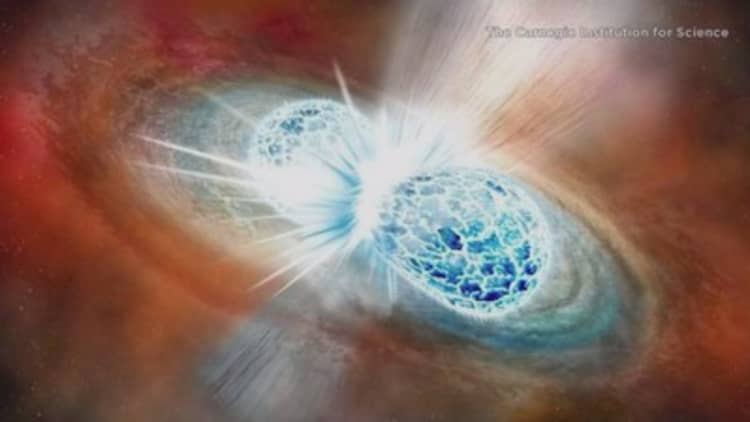
Scientists have detected the collision of two neutron stars for the first time in history, yielding new insights into physics, the structure of the universe, and the origin of elements such as gold and platinum.
Researchers from several institutions detected the evidence 130 million light years away on Aug. 17. They announced the discovery Monday.
The collision was detected both through gravitational waves and through telescopes, which has never been done before. The combination of these two different types of data solves many long-standing puzzles and opens the door to a whole new kind of astronomy.
"This is an amazing, amazing discovery," said David Reitze, executive director, LIGO Laboratory/Caltech, told reporters at a news conference in Washington, D.C., on Monday.
The gravitational waves were first detected by the Virgo interferometer in Europe, then by both Laser Interferometer Gravitational-Wave Observatory (LIGO) locations in Louisiana and Washington state milliseconds later. LIGO is also the place where gravitational waves have been previously detected. Three scientists from LIGO won the 2017 Nobel Prize in physics for earlier work on the project.
At around the same time, NASA's Fermi telescope picked up a short gamma-ray burst — a pulse of light from the explosion made as the neutron stars merged.
Neutron stars are extremely dense bodies made purely of neutrons and produced by the explosion of supernovae. They have about 1.5 times the mass of the sun, crushed into a body about the size of a medium-sized city, such as San Francisco. Scientists had theorized that these bodies merged, but this is the first time they have ever been spotted.
"This is like a cosmic-scale atom smasher of energies far beyond what humans will ever be capable of building," said Andy Howell, a staff scientist at Las Cumbres Observatory/UC Santa Barbara.
The findings are numerous. Using the data, LIGO and Virgo scientists have developed a new method for using the gravitational wave signals to measure the rate at which the universe is expanding, something scientists have been trying to do for a long time.
"So welcome to the new era of gravitational wave cosmology," said Laura Cadonati, associate professor at School of Physics Georgia Institute of Technology.
They also discovered that the gravitational waves travel at the speed of light, something Albert Einstein predicted about a century ago.
The discovery also showed that the collisions of neutron stars produce neutron-rich heavy elements, something astronomers had suspected.
"This result provides definitive evidence for the first time that elements such as platinum, gold, and uranium are actually produced in these collisions," Reitze said.
Holding up his grandfather's pocket watch, Reitze said the gold in the watch was "very likely" produced by the collision of two neutron stars.
Findings have been published in several scientific journals, including Science, Nature, Physical Review Letters and The Astrophysical Journal, said NASA in a news release.


